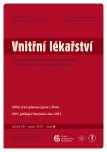Recent possibilities of treatment of End Stage Renal Desease
Authors:
O. Viklický; S. Rajnochová‑ bloudíčková
Authors‘ workplace:
Klinika nefrologie, Transplantační centrum IKEM Praha, přednosta prof. MU Dr. Ondřej Viklický, CSc.
Published in:
Vnitř Lék 2013; 59(8): 747-751
Category:
Overview
The End Stage Renal Deasease (ESRD) represents a significant medical and economic problem. The success of long‑term outcome of ESRD is dependent on the adequate nephrological care. The treatment of choice represents a kidney transplantation from a living donor or in those who haven´t got such possibility, a deceased donor kidney transplantation. Recently, number of living donor kidney transplants has been increasing during last years in Europe and USA, mainly because of large awareness campaign and by using incompatible pairs. There were 361 (34.3 pmp) deceased donor and 71 (6.7 pmp) living donor kidney transplants performed while 4,050 patients benefit the life with functioning kidney graft in the Czech Republic in 2012. Hemodialysis therapy had undergone 5,772 (550 pmp) while peritoneal dialysis 489 (47 pmp) patients on December 31st, 2012.
Key words:
ESRD - chronic kidney disease – dialysis – transplantation – peritoneal dialysis – CKD – Czech Republic
Sources
1. Meier‑ Kriesche HU, Schold JD. The impact of pretransplant dialysis on outcomes in renal transplantation. Semin Dial 2005; 18: 499– 504.
2. Meier‑ Kriesche HU, Port FK, Ojo AO et al. Effect of waiting time on renal transplant outcome. Kidney Int 2000; 58: 1311– 1317.
3. Gill JS, Rose C, Pereira BJ et al. The importance of transitions between dialysis and transplantation in the care of end‑stage renal disease patients. Kidney Int 2007; 71: 442– 447.
4. Delmonico F. A report of the Amsterdam forum on the care of the live kidney donor: data and medical guidelines. Transplantation 2005; 79 (Suppl 6): S53– S66.
5. Genberg H, Kumlien G, Wennberg L et al. Isoagglutinin adsorption in ABO‑ incompatible transplantation. Transfus Apher Sci 2010; 43: 231– 235.
6. Segev DL, Simpkins CE, Warren DS et al. AB0 incompatible high‑titer renal transplantation with-out splenectomy or anti‑CD20 treatment. Am J Transplant 2005; 5: 2570– 2575.
7. Montgomery RA. Renal transplantation across HLA and AB0 antibody barriers: integrating paired donation into desensitization protocols. Am J Transplant 2010; 10: 449– 457.
8. Wadström J. Hand‑ assisted retroperitoneoscopic live donor nephrectomy: experience from first 75 consecutive cases. Transplantation 2005; 80: 1060– 1066.
9. Foley RN, Ibrahim HN. Long‑term outcome of kidney donors. Curr Opin Nephrol Hypertens 2010; 19: 129– 133.
10. Danovitch GM, Hariharan S, Pirsch JD et al. Clinical Practice Guidelines Committee of the American Society of Transplantation. Management of the waiting list for cadaveric kidney transplants: report of a survey and recommendations by the Clinical Practice Guidelines Committee of the American Society of Transplantation. J Am Soc Nephrol 2002; 13: 528– 535.
11. Wauters JP, Lameire N, Davison A et al. Why patients with progressing kidney disease are referred late to the nephrologist: on causes and proposals for improvement. Nephrol Dial Transplant 2005; 20: 490– 496.
12. Chow KM, Szeto CC, Law MC et al. Impact of early nephrology referral on mortality and hospitalization in peritoneal dialysis patients. Perit Dial Int 2008; 28: 371– 376.
13. KDIGO 2013. Clinical Practice Guideline for the Evaluation and Management of Chronic Kidney Disease. Kidney Int Supplement 2013; 3: 19– 62.
14. Česká nefrologická společnost. Dostupné na: www.nefrol.cz.
Labels
Diabetology Endocrinology Internal medicineArticle was published in
Internal Medicine

2013 Issue 8
Most read in this issue
- Liver transplants in tumours and alcoholic cirrhoses
- Immunosuppression after liver transplant, now and in future
- New drugs in type 2 diabetes mellitus therapy
- Liver transplant indication and waiting list inclusion
